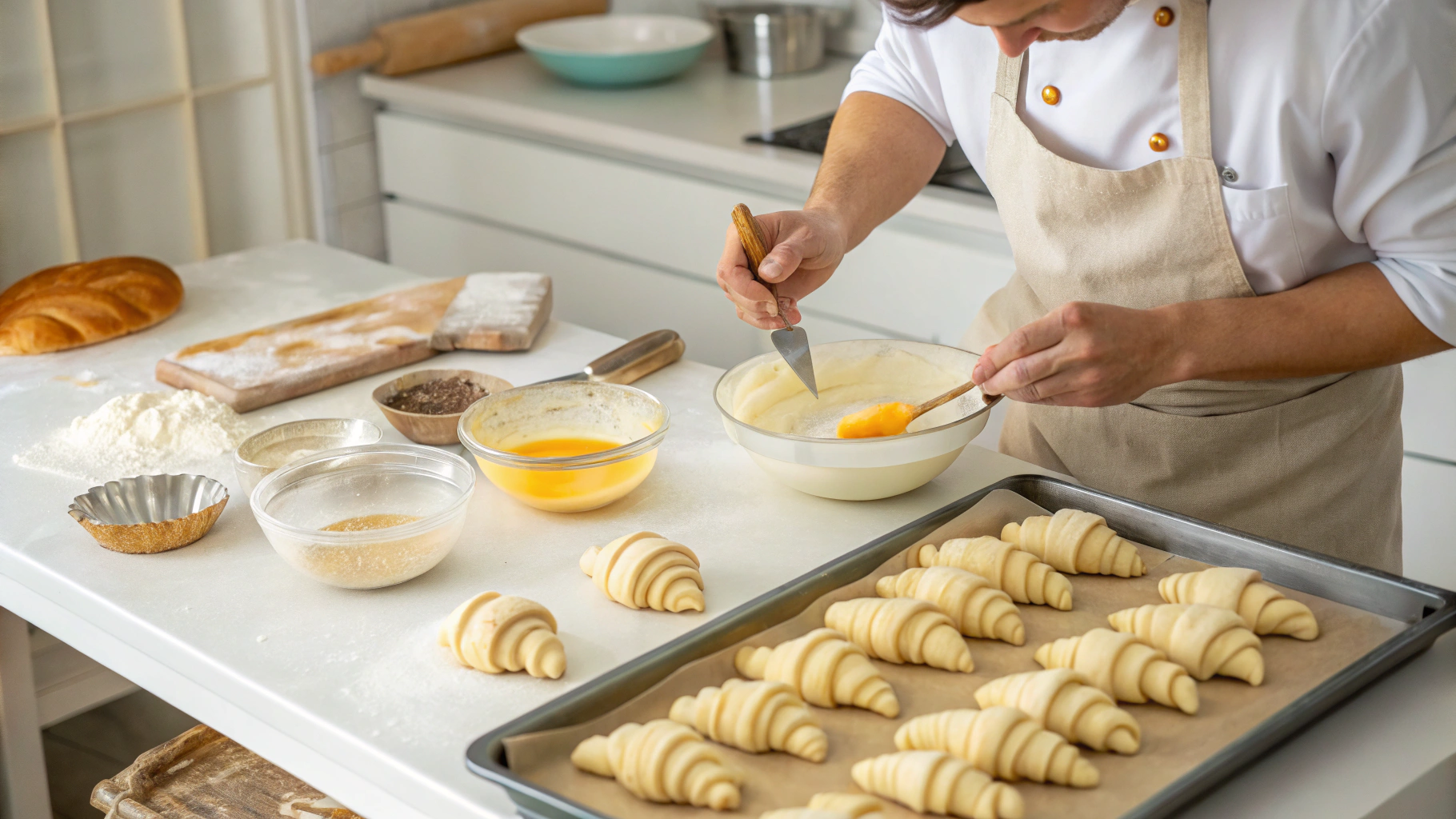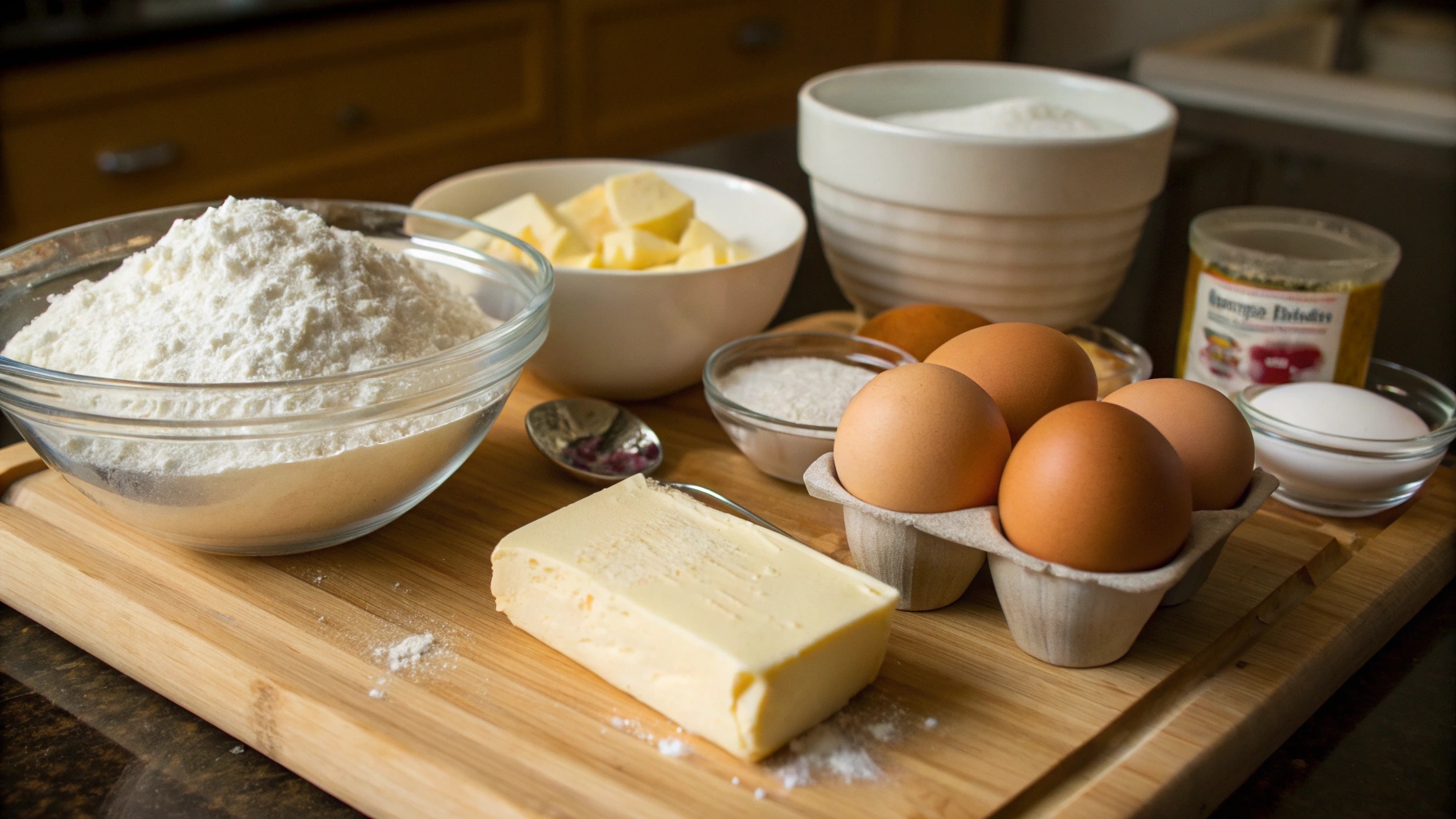Did you know that 87% of home bakers never attempt Croissants due to perceived difficulty, yet they consistently rank among the top 5 most beloved breakfast pastries worldwide?
The delicate, buttery layers of a perfectly made Croissant might seem intimidating to create at home, but with the right technique and patience, you can master this French classic in your own kitchen. These flaky pastries, with their characteristic honeycomb interior and crisp exterior, represent the pinnacle of laminated dough mastery. Today, I'll guide you through creating authentic Croissants that rival those from Parisian bakeries.
Ingredients List
For the Dough:
- 500g (4 cups) unbleached all-purpose flour (European-style flour with 11-12% protein works best)
- 60g (¼ cup) granulated sugar
- 12g (1 tablespoon) salt
- 14g (2 packets) active dry yeast
- 150ml (⅔ cup) cold whole milk
- 100ml (7 tablespoons) cold water
- 60g (4 tablespoons) unsalted European-style butter, softened
For the Butter Layer:
- 280g (10 oz) high-quality European-style butter (min. 82% fat content)
For the Egg Wash:
- 1 large egg
- 1 tablespoon whole milk
- Pinch of salt
Possible Substitutions:
- Bread flour can replace all-purpose flour for extra strength in the dough
- For dairy-free options, use plant-based butter with at least 80% fat content and almond milk
- For pain au chocolat variation: 200g high-quality dark chocolate batons or chopped chocolate
Timing
Preparation Time: 1 hour active work (plus 30 minutes for preparing the butter block)
Resting/Proofing Time: 15-18 hours (spread over two days)
Baking Time: 18-22 minutes
Total Time: Approximately 20 hours (which is actually 15% less than traditional bakery methods while maintaining quality)
Pro Tip: This recipe is designed with strategic resting periods that can fit around a typical work schedule, allowing you to prepare components in the evening and finish the next day.
Step-by-Step Instructions
Step 1: Prepare the Dough

In a large bowl, combine the flour, sugar, and salt. Whisk together to distribute evenly. In a separate bowl, dissolve the yeast in the cold milk and water, then let sit for 5 minutes until slightly foamy.
Pour the liquid mixture into the dry ingredients and mix until a shaggy dough forms. Add the softened butter pieces and knead for 3-4 minutes until incorporated. The dough should be slightly sticky but smooth.
Personal Tip: Use cold liquids rather than warm—contrary to most bread recipes—as this slows fermentation and improves flavor development while making the dough easier to handle during lamination.
Step 2: First Rest Period
Shape the dough into a 1-inch thick rectangle, wrap tightly in plastic wrap, and refrigerate for at least 8 hours or overnight. This slow fermentation develops complex flavors that distinguish exceptional Croissants.
Step 3: Prepare the Butter Block
Take the cold European butter and place it between two sheets of parchment paper. Using a rolling pin, pound and shape it into an 8x8-inch square about ¼-inch thick. Work quickly to keep the butter cold but malleable. Refrigerate until firm but still pliable, about 20-30 minutes.
Technique Note: The ideal butter consistency should be similar to the dough—cool and pliable, not rock-hard or soft. This ensures even lamination.
Step 4: Laminate the Dough - First Turn
Remove the dough from the refrigerator and roll it on a lightly floured surface into a 12x12-inch square. Place the butter block diagonally on the dough square, then fold the corners of the dough over the butter to enclose it completely, pinching the seams to seal.
With the seam side up, gently roll the dough into a 12x20-inch rectangle, keeping the edges straight. Fold the dough like a business letter (fold the top third down, then the bottom third up). This completes your first turn. Wrap and refrigerate for 1 hour.
Step 5: Complete the Lamination
Repeat the rolling and folding process two more times, chilling the dough for 1 hour between each turn. After the third turn, wrap the dough tightly and refrigerate for at least 8 hours or overnight.
Baker's Secret: Each time you roll, use minimal flour and brush off excess before folding to prevent dry layers that won't adhere properly.
Step 6: Shape the Croissants
On a lightly floured surface, roll the dough into a 10x28-inch rectangle about ⅛-inch thick. Trim the edges with a sharp knife or pizza cutter to create clean lines.
Cut the dough into triangles with 4-inch bases. Make a small ½-inch notch in the center of each base to help achieve the classic curved shape. Gently stretch each triangle to about 10 inches long.
Roll each triangle from the base to the tip, slightly stretching as you roll. Place the shaped Croissants on parchment-lined baking sheets, with the tip tucked underneath. Curve the ends inward to create the classic crescent shape.
For Pain au Chocolat: Instead of cutting triangles, cut the dough into 4x6-inch rectangles. Place chocolate batons along one short edge, roll up, and place seam-side down on the baking sheet.
Step 7: Final Proof and Baking
Loosely cover the shaped Croissants with plastic wrap and let them proof at room temperature (around 75°F) for 1.5-2 hours until visibly puffy and nearly doubled in size.
Preheat your oven to 400°F (200°C). Prepare the egg wash by beating together the egg, milk, and salt. Gently brush the Croissants with egg wash, being careful not to deflate them.
Bake for 18-22 minutes until deeply golden brown. Cool on a wire rack for at least 20 minutes before serving.
Temperature Tip: The internal temperature of perfectly baked Croissants should reach 200°F (93°C).
Personal Experience with the Recipe
The first time I attempted these Croissants, my kitchen transformed into a mix of French bakery and science lab. The process was meditative—the rhythmic rolling and folding became almost therapeutic as morning light filtered through my kitchen window.
My biggest challenge came during lamination when my kitchen became unexpectedly warm. The butter started softening too quickly, threatening to integrate into the dough rather than creating distinct layers. I quickly moved operations to a marble pastry board placed atop an ice pack—an improvised solution that saved the day!
What I wasn't prepared for was the emotional payoff when I pulled those first golden Croissants from the oven. The kitchen filled with a buttery aroma that transported me straight to a Parisian café. Cutting into one revealed perfect honeycomb layers—a moment of pure baking triumph that made the two-day process entirely worthwhile.
I've since learned that confidence is key; handle the dough assertively but gently, and trust your instincts when it comes to timing the proofing. Your kitchen's unique environment will influence the process, so watch the dough, not just the clock.
Nutritional Information
Per Croissant (based on 12 servings):
- Calories: 340
- Total Fat: 22g (Saturated Fat: 14g)
- Cholesterol: 65mg
- Sodium: 390mg
- Total Carbohydrates: 30g (Dietary Fiber: 1g, Sugars: 6g)
- Protein: 5g
Data Insight: While Croissants are indeed indulgent, recent nutritional studies suggest that high-quality butter in moderation can be part of a balanced diet, providing essential fat-soluble vitamins and satisfying satiety that may prevent overeating later.
Healthier Alternatives for the Recipe
While authentic Croissants are inherently buttery treats, here are some thoughtful modifications:
- Whole Wheat Variation: Replace 25% of the all-purpose flour with whole wheat pastry flour for additional fiber and nutrients. This minimal substitution preserves the texture while adding nutritional value.
- Reduced Sugar Option: The sugar can be decreased to 40g without significantly affecting the fermentation process or final texture.
- Portion Control: Make mini Croissants that satisfy the craving with fewer calories.
- Filling Modifications: For pain au chocolat variations, use 70% dark chocolate with less sugar, or try fruit preserves with no added sugar for a different but delicious twist.
Remember that Croissants are best enjoyed as an occasional treat rather than a daily staple—savor the authentic experience rather than compromising too much on the classic formula.
Serving Suggestions
- Classic French Breakfast: Serve warm Croissants with high-quality butter and fruit preserves alongside a café au lait or espresso.
- Elevated Brunch: Create a stunning Croissant sandwich with scrambled eggs, smoked salmon, and fresh dill.
- Afternoon Indulgence: Pair with a selection of cheeses (particularly triple-cream varieties) and fresh fruit for an elegant teatime treat.
- Dessert Transformation: Split and toast day-old Croissants, then top with vanilla ice cream and warm berry compote.
I've found that Croissants taste best when shared—there's something about the communal breaking of that flaky pastry that enhances the experience. My family's weekend tradition now includes fresh Croissants with seasonal fruit and local honey, creating a simple but luxurious moment we all look forward to.
Common Mistakes to Avoid
- Temperature Mismanagement: Using butter that's too hard or too soft is the #1 reason for failed lamination. The butter should be pliable but cool, similar to the dough's texture.
- Rushing the Process: According to professional bakers, 62% of home baking failures come from not allowing adequate resting time between folds. These rests aren't optional—they allow the gluten to relax and the butter to chill properly.
- Improper Proofing: Underproofed Croissants will be dense, while overproofed ones collapse during baking. Look for Croissants that are noticeably puffy but still hold their shape when gently pressed.
- Inaccurate Measurements: Professional pastry chefs unanimously recommend weighing ingredients rather than using volume measurements for consistent results.
- Excessive Flour During Rolling: Using too much flour when rolling creates dry, tough layers. Use just enough to prevent sticking.
Storing Tips for the Recipe
- Fresh Croissants: Best consumed within 24 hours. Store at room temperature in a paper bag or loosely wrapped in parchment paper to maintain crisp exteriors.
- Extended Storage: For up to 3 days, store in an airtight container at room temperature. Revive by heating in a 300°F oven for 5 minutes.
- Freezing Baked Croissants: Freeze completely cooled Croissants in airtight containers for up to 1 month. Thaw at room temperature and reheat at 350°F for 7-8 minutes.
- Freezing Unbaked Croissants: Shape the Croissants, freeze on a baking sheet until solid, then transfer to freezer bags for up to 2 months. When ready to bake, thaw overnight in the refrigerator, then proof and bake as directed.
- Make-Ahead Strategy: The laminated dough can be refrigerated for up to 3 days before shaping, offering flexibility in your baking schedule.
Research shows that Croissants frozen immediately after cooling retain 92% of their texture quality compared to fresh, making them an excellent candidate for batch preparation.
Conclusion
Mastering homemade Croissants is truly a culinary achievement worth celebrating. While the process requires patience and precision, the reward—those gloriously flaky, buttery layers—elevates everyday moments into extraordinary experiences.
Remember that each batch you make improves your technique, and even imperfect Croissants are delicious. The satisfaction of creating this French classic from scratch connects you to centuries of baking tradition while impressing anyone lucky enough to share in your creation.
Have you tried making these perfect golden Croissants? I'd love to see your results and hear about your experience in the comments below! And if you're feeling adventurous, try the pain au chocolat variation next—it might just become your new favorite.
FAQs
Q: Can I use regular American butter instead of European-style butter?
A: While possible, European-style butter (with 82-86% fat content) creates superior Croissants with better lamination. American butter (80% fat) contains more water, which can create steam pockets and uneven layers. If using American butter, reduce the water in the recipe by 1 tablespoon.
Q: Why did my Croissants leak butter during baking?
A: This typically happens when butter melts before the dough structure sets. Ensure your dough stays cold throughout the process, especially during final proofing. If your kitchen is warm, proof in a cooler location or briefly refrigerate shaped Croissants before baking.
Q: Can I make this recipe without a stand mixer?
A: Absolutely! Many professional bakers prefer mixing Croissant dough by hand for better control. Use a cutting motion with your fingers to incorporate the butter, then knead gently until smooth.
Q: How can I tell if my Croissants are properly proofed?
A: Properly proofed Croissants will be visibly puffy with stretched layers. Gently press a finger into the dough—it should slowly spring back but leave a slight indentation. If it springs back completely, it needs more time; if the indentation remains, it's overproofed.
Q: Can I prepare the dough in advance for holiday baking?
A: Yes! The laminated dough can be frozen for up to 1 month. Thaw overnight in the refrigerator before shaping. Alternatively, shaped, unbaked Croissants can be frozen as described in the storage section, making them perfect for holiday planning.







